| Home | Nature Weekly Index |
7 May 2017 | Ladybird Beetles | Illeis koebelei | Heteroneda reticulata |
While going about my first field trial of my macro photography equipment in a nearby park last weekend, I came across a mass appearance of Yellow Ladybird Beetle (Illeis koebelei). They were either resting on or crawling on different plants and on rocks that were used as stools in the park. Larvae and pupae were also present in the area. One of the beetle appeared to have a deformed wing cases (elytra). This small ladybird beetle with a length of about 4 to 5 millimetres was one of the dominant ladybird beetles in this park. Not many people had observe it due the small size of the beetle.
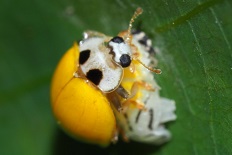
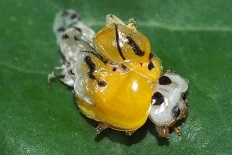
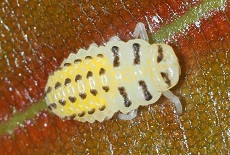
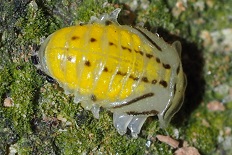
Apparently, this beetle was a rather well-known mycophagous ladybird that feed on fungus, specifically powdery mildew which is a causative agent of a type of plant disease. In a Japanese article published in 2000 [1], the beetle was found to consumed 11 species of powdery mildews. Two other articles from Taiwan and Korea published in 2010 [2] and 2015 [3] respectively highlighted its potential use as a biological control agent against powdery mildews attack. Contrary to our common knowledge, not all ladybird prey on aphids.
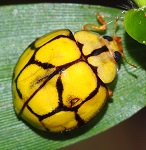
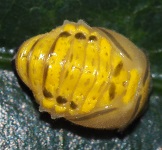
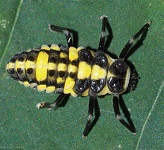 In the same park, there was another yellow ladybird beetle ---
Netty Ladybird Beetle (Heteroneda reticulata).
Its number were far less than the beetle mentioned above. I had only seen two of them in the past 2 trips to the park.
However, there were many of its pupae around. Its pupa was identified based on the same picture showed in
Nicky Bay’s Ladybird Beetles website.
There was another type of ladybird larva with black coloured legs crawling around which might be link to this ladybird
beetle. This beetle goes by another common name, tortoise-shelled ladybird, likely due to the resemblance of its netted
shell to that of a tortoise. It also goes by another scientific name (synonym)
Heteroneda billardieri. This beetle was the theme of a
Singapore stamp back in 1985. It is a predatory beetle that
targets mango leafhopper [4].
In the same park, there was another yellow ladybird beetle ---
Netty Ladybird Beetle (Heteroneda reticulata).
Its number were far less than the beetle mentioned above. I had only seen two of them in the past 2 trips to the park.
However, there were many of its pupae around. Its pupa was identified based on the same picture showed in
Nicky Bay’s Ladybird Beetles website.
There was another type of ladybird larva with black coloured legs crawling around which might be link to this ladybird
beetle. This beetle goes by another common name, tortoise-shelled ladybird, likely due to the resemblance of its netted
shell to that of a tortoise. It also goes by another scientific name (synonym)
Heteroneda billardieri. This beetle was the theme of a
Singapore stamp back in 1985. It is a predatory beetle that
targets mango leafhopper [4].
The park hosted a third ladybird beetle (Chilocorus circumdatus) which was red in colour. Its size was similar to the yellow ladybird. I had shared a picture of both the red and yellow ladybird beetles in a post back in February 2015 when I visited this same park.
Reference:
[1] Takeuchi M, Sasaki Y, Sato C, Iwakuma S, Isozaki A, Tamura M. Seasonal host utilization of mycophagous ladybird Illeis koebelei (Coccinellidae: Coleoptera). Japanese J Appl Entomol Zoology 2000;44(2):89-94. | Read article |
[2] Sung IH, Wu YF, Lin MY, Chen SK. Seasonal occurrence, hosts, life history and the biocontrol potential of a mycophagus ladybird Illeis koebelei (Coleoptera: Coccinellidae: Halyziini) in Southern Taiwan. Formosan Entomol 2010; 30:247-261. | Read article |
[3] Lee YS, Jang MJ, Lee JG, Kim JR, Lee JH. Host plants and biological characteristics of Illeis koebelei Timberlake (Coleoptera: Coccinellidae: Halyziini) in Gyeonggi-do. Korean J Appl Entomol 2015;54(4):295-301. | Read article |
[4] Barcos AKS, Velasco LRI, Medina C. Foraging behavior of the Yellow Netted Ladybeetle Heteroneda billardieri Crotch (Coleoptera: Coccinellidae). Philipp Agric Scientist 2014;97(2):155-160. | Read article |